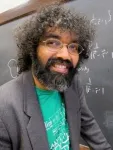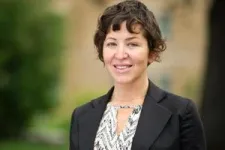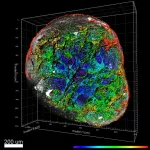(Press-News.org)
In art, the negative space in a painting can be just as important as the painting itself. Something similar is true in insulating materials, where the empty spaces left behind by missing electrons play a crucial role in determining the material's properties. When a negatively charged electron is excited by light, it leaves behind a positive hole. Because the hole and the electron are oppositely charged, they are attracted to each other and form a bond. The resulting pair, which is short lived, is known as an exciton [pronounced exit-tawn].
Excitons are a key part of many technologies, including solar panels, photodetectors and sensors, as well as light-emitting diodes found in televisions and digital display screens. In most cases, the exciton pairs are bound by electrical, or electrostatic, forces, also known as Coulomb interactions. Now, in a new study in Nature Physics, Caltech researchers report detecting excitons that are not bound via Coulomb forces but rather by magnetism. This is the first experiment to detect how these so-called Hubbard excitons, named after the late physicist John Hubbard, form in real-time.
"Using an advanced spectroscopic probe, we were able to observe in real time the generation and decay of magnetically bound excitons, the Hubbard excitons," says study lead author Omar Mehio (PhD '23), a recent graduate student at Caltech who worked with David Hsieh, the Donald A. Glaser Professor of Physics at Caltech. Mehio is now a postdoctoral fellow at the Kavli Institute at Cornell.
"In most insulators, oppositely charged electrons and holes interact with one another just as an electron and a proton bind to form a hydrogen atom," Mehio explains. "However, in a special class of materials known as Mott insulators, the photo-excited electrons and holes instead bind through magnetic interactions."
The results could have applications in the development of new exciton-related technologies, or excitonics, in which the excitons would be manipulated through their magnetic properties. "Hubbard excitons and their magnetic binding mechanism demonstrate a drastic departure from the paradigms of traditional excitonics, creating the opportunity to develop a whole ecosystem of novel technologies that are fundamentally unavailable in conventional excitonic systems," Mehio says. "Having excitons and magnetism strongly intertwined in a single material could lead to new technologies that harness both properties."
To create the Hubbard excitons, the researchers applied light to a type of insulating material known as an antiferromagnetic Mott insulator. These are magnetic materials in which the electron spins are aligned in a repeating, stable pattern. The light excites the electrons, which jump to other atoms, leaving holes behind.
"In these materials, when an electron or hole moves through the lattice, they leave in their wake a string of magnetic excitations," Mehio says. "Imagine you tie one end of an elastic rope around your friend, and the other end around yourself. If your friend runs away from you, you will feel the rope pull you in that direction and you will begin to follow. This scenario is analogous to what happens between a photo-excited electron and the hole it leaves behind in a Mott insulator. With Hubbard excitons, the string of magnetic excitations between the pair serves the same role as the rope connecting you to your friend."
To demonstrate the existence of the Hubbard excitons, the researchers used a method called ultrafast time-domain terahertz spectroscopy, which allowed them to look for the very short-lived signatures of the excitons at very low-energy scales. "Excitons are unstable because the electrons want to go back into the holes," Hsieh explains. "We have a way of probing the short time window before this recombination occurs, and that allowed us to see that a fluid of Hubbard excitons is transiently stabilized."
The study, titled "A Hubbard exciton fluid in a photo-doped antiferromagnetic Mott insulator," was funded by the Army Research Office, the David and Lucile Packard Foundation, the National Science Foundation, Caltech's Institute for Quantum Information and Matter (an NSF Physics Frontiers Center), Caltech, the German Research Foundation, the Gordon and Betty Moore Foundation, and the Slovenian Research Agency. Other authors include Xinwei Li, Honglie Ning (PhD '23), and Nicholas Laurita, all formerly of Caltech; Caltech graduate student Yuchen Han; Zala Lenarčič of the Jozef Stefan Institute in Slovenia and UC Berkeley; Michael Buchhold of the University of Cologne in Germany (and a former Caltech postdoc); and Zach Porter and Stephen Wilson of UC Santa Barbara.
END
The American College of Cardiology has announced Julie Damp, MD, FACC, as the next vice chair of the American College of Cardiology’s Annual Scientific Session. Damp will serve as vice chair for ACC.25 and ACC.26 and transition to chair for ACC.27 and ACC.28.
"ACC Annual Scientific Session is an incredibly impactful learning experience for cardiovascular care providers globally,” Damp said. “I am truly honored and excited to have the opportunity to work with the ACC team to provide effective and innovative education that impacts the care of our patients and expands the reach of cardiovascular science."
Damp is a professor of medicine in cardiovascular medicine ...
A new study may offer a strategy that mitigates negative side effects associated with intravenous injection of nanoparticles commonly used in medicine.
The study was published today in Nature Nanotechnology.
“Nanotechnology’s main advantage over conventional medical treatments is its ability to more precisely target tissues, such as cancer cells targeted by chemotherapy. However, when nanoparticles are injected, they can activate part of the immune system called complement,” said senior author Dmitri Simberg, Ph.D., professor of Nanomedicine and Nanosafety at the University of Colorado Skaggs School of Pharmacy ...
A technology being studied to curb climate change – one that could be put in place in one or two decades if work on the technology began now – would affect food productivity in parts of planet Earth in dramatically different ways, benefiting some areas, and adversely affecting others, according to projections prepared by a Rutgers-led team of scientists.
Writing in the journal, Nature Food, the scientists described the results of computer models simulating varying climate scenarios and their impacts over time on the production of the world’s four major food crops: ...
About The Study: In this study of 4,070 insured adults with diabetes, disparities in poor glycemic control persisted despite adjustment for social, health care, and behavioral factors. Research is needed to identify the barriers contributing to poor control even in populations with access to care.
Authors: Sandra S. Albrecht, Ph.D., M.P.H., of the Columbia University Mailman School of Public Health in New York, is the corresponding author.
To access the embargoed study: Visit our For The Media website at this link https://media.jamanetwork.com/
(doi:10.1001/jamanetworkopen.2023.36307)
Editor’s Note: Please see the article ...
About The Study: This study of 26.9 million individuals in four Canadian provinces found that cannabis legalization with restrictions was not associated with an increase in hospitalizations due to cannabis but commercialization was. The findings suggest that commercialization of cannabis may be associated with increases in cannabis-related health harms, including cannabis-induced psychosis.
Authors: Daniel T. Myran, M.D., M.P.H., of the Ottawa Hospital Research Institute in Ottawa, Ontario, Canada, is the corresponding author.
To ...
About The Study: In a representative sample of emergency department chest radiographs, results suggest that the generative artificial intelligence (AI) model produced reports of similar clinical accuracy and textual quality to radiologist reports while providing higher textual quality than teleradiologist reports. Implementation of the model in the clinical workflow could enable timely alerts to life-threatening pathology while aiding imaging interpretation and documentation.
Authors: Mozziyar Etemadi, M.D., Ph.D., of Northwestern Medicine ...
They’re being hailed as an effective way to lose weight, but diabetes drugs like Ozempic may come with a heightened risk of severe gastrointestinal problems.
That’s according to new research from the University of British Columbia showing that medications known as GLP-1 agonists—which includes brands like Wegovy, Ozempic, Rybelsus and Saxenda—are associated with an increased risk of serious medical conditions including stomach paralysis, pancreatitis and bowel obstruction.
While previous studies highlighted some of these risks in patients with diabetes, this is the first large, population-level study to examine adverse gastrointestinal ...
When the new SARS-CoV-2 virus began killing thousands of people every week, physicians and scientists around the globe raced to learn why the new pathogen was so deadly. Among many early findings, experts noted that the infection played havoc with blood circulation, both inflaming the linings of blood vessels and making the blood itself more likely to form dangerous clots.
Critically ill COVID-19 patients suffered pulmonary embolisms, deep vein thrombosis (DVT), arterial thrombosis, as well as microvascular thrombosis affecting tissues of the lungs, kidneys, and heart.
Doctors tried a wide array of existing medications in hopes of controlling the blood system impacts, with mixed ...
New research has shed light on how genetics influences the growth of the placenta, revealing a link to risk of disease in the mother.
Scientists from the University of Exeter worked with colleagues in Norway and Denmark to lead a largescale international collaboration which examined placental growth in the greatest detail yet. They caried out the first ever genome-wide association study of the weight of the placenta at birth, generating a number of revelations. Among the findings published in Nature Genetics, the team concluded that faster growth of the placenta can contribute to risk of preeclampsia, and to earlier delivery ...
Creating artificial life is a recurring theme in both science and popular literature, where it conjures images of creeping slime creatures with malevolent intentions or super-cute designer pets. At the same time, the question arises: What role should artificial life play in our environment here on Earth, where all life forms are created by nature and have their own place and purpose?
Associate professor Chenguang Lou from the Department of Physics, Chemistry, and Pharmacy, University of Southern Denmark, together with Professor Hanbin Mao from Kent State University, is the parent of a special artificial hybrid molecule that could lead to ...




